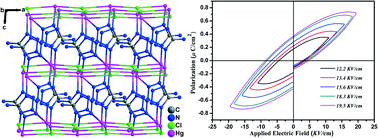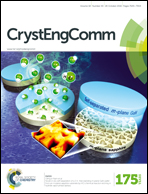Syntheses, structures and investigation of the properties of mercury coordination polymers based on 5-amino-tetrazolate ligands†
Abstract
Four new mercury coordination polymers were successfully synthesized under solvothermal conditions and characterized by elemental analysis, IR spectroscopy, thermal analysis, powder X-ray diffraction and single-crystal X-ray diffraction. In these complexes, the chemical valence of mercury is +2, except for complex 1 which is +1. 1 contains [Hg2]2+ metal–metal bonded cores which are bounded by atz− (Hatz = 5-amino-tetrazolate) ligands and features a two-dimensional (2D) uninodal 3-connected ‘hcb’ network. 2 exhibits a trinodal 3D (3,6)-connected ‘apo/alpha-PbO2’ topological net in which 2D [HgCl]nn+ inorganic cation layers are pillared by atz− ligands. In 3, the 2D [HgCl]nn+ cation layers are interconnected by atz− ligands, affording a trinodal 3D (3,6)-connected ‘flu/fluorite’ topological net. 4 is a 3D pillared-layer metal–organic framework based on mixed atz− and isonicotinic ligands, showing a binodal (4,6)-connected ‘fsc’ coordination network. In this work, 1 and 4 were synthesized from an in situ generated tetrazolate ligand, while 2 and 3 were prepared from a commercially available tetrazolate ligand. These results indicate that the final structures of the target complexes will highly depend on the synthetic conditions as well as the preparation methods. Moreover, the photoluminescence properties of these complexes were investigated. Impressively, the non-centrosymmetric complex 3 displays not only a second harmonic generation (SHG) response but also a ferroelectric behavior.


 Please wait while we load your content...
Please wait while we load your content...